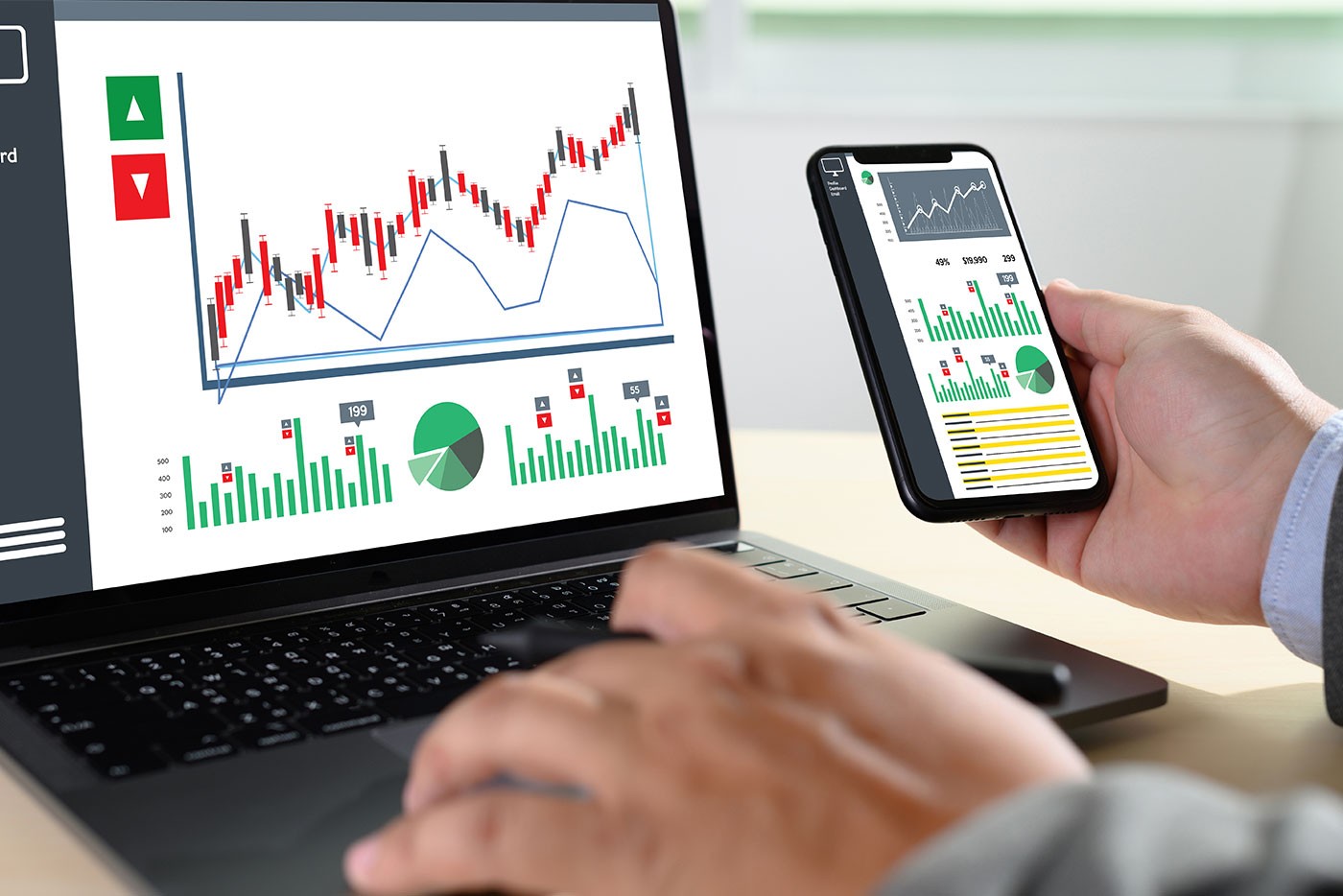Users of the Google search engine and its affiliated networks are exposed to hundreds of ads every day. These Google ads are an integral part of the search engine because it allows Google to earn revenue.
From a users perspective, ads are equally important for businesses and new websites as it allows them to generate quick revenues instead of spending countless hours on SEO. In fact, large businesses also love Google Ads because they can create awareness for their new products.
Overall, Google Ads offers a win-win situation for everyone involved.
If you’re interested in using Google Ads to generate traffic, this article will offer useful insight into the Google ads industry benchmarks. Using the benchmark, website owners and businesses can get answers to the following questions:
- Is Google Ads Right For Me?
- Which Type of Google Ads Should I Use?
- How To Use Google Ads To Your Advantage?
Before answering any of these questions, it’s important to understand the type of Ads that you can use on Google.
Types of Google Ads
There are mainly two types of Google Ads: Search Ads and Display Ads.
Search Ads
Search ads are advertisements seen on top of the Google search results. These search ads are related to the keyword search and look very similar to organic results shown in Google. Depending on the keyword, they’re usually displayed above organic results. For instance:
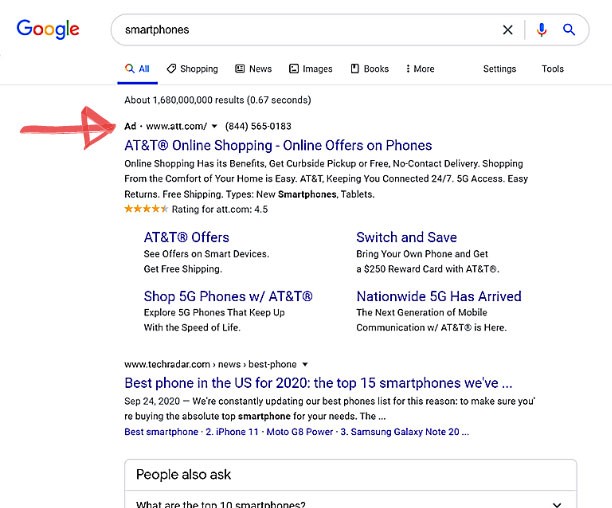
Display Ads
In contrast, Google display ads are mostly visual advertisements in the form of banner ads that are displayed to the user-defined audience. Since these google display ads are not keyword-driven, they can be shown on Google and on the website of its partners to the targeted audience at a specific time. For example:
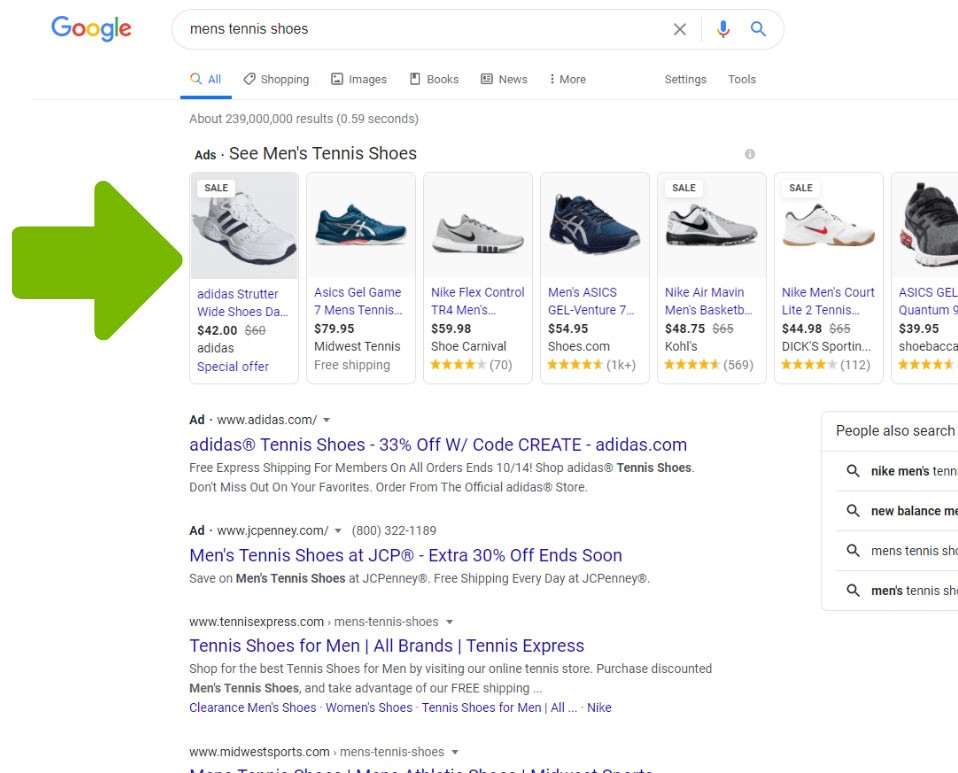
Irrespective of the type of ad, it’s interesting to know that the behavior of Google ads and their results can differ according to the platform used. For instance, the click-through-rate of a search ad may differ significantly on mobile and laptop. Therefore, it also makes sense to compare the effectiveness of search ads and display ads on different platforms.
Google Adwords Industry Benchmarks
If you want to decide if Google ads are for you, certain benchmarks can help you make a decision. These are:
- CTR (Click-through-rate)
- CPC (Cost-per-click)
- CPA (Cost-per-action)
CTR (Click-Through-Rate)
According to comprehensive wordstream research, the google adwords ctr benchmark is 3.17%. Similarly, the average click-through-rate of display ads is 0.46%.
In simple words, it means that you should expect to see almost 317 customers clicking on your search ads if it’s displayed 10,000 times. On the display network, the rate of click is relatively low so you can only expect 46 individuals to click on your ad.
We can set-up and optimize your Google Ads for you but let’s also test your website’s SEO potential. Takes 60 seconds!
Paying for traffic is an important way for many businesses to grow but ranking naturally in Google for your important keywords is free. While Diib helps 1000s of businesses grow with Google Ads management, Diib is also one of the best SEO tools in the world and uses the power of big data to help you quickly and easily increase your traffic and rankings. Diib will even let you know if you already deserve to rank higher for certain keywords. As seen in Entrepreneur!
- Over 500,000 global members
- Keyword and backlink monitoring + ideas
- Built-in benchmarking and competitor analysis
- Easy-to-use automated SEO tool
- Speed, security, + Core Vitals tracking
- Too busy for SEO? Diib’s Growth Experts can set-up and optimize your ads!
Used by over 500k companies and organizations:
Syncs with 
Another important parameter to consider is the fact that the average click-through-rate can differ significantly in the type of niche. For instance, the dating and matchmaking industry usually enjoys a very higher CTR of about 6.05%. The average CTR of this niche on the Google display network is 0.72% compared to the average of 0.46% across all industries. On the other side, the technology sector has the lowest CTR of major industries. The Google search ads CTR benchmark for the tech sector is 2.09%; whereas, display ads on the Google network offer a CTR of 0.39%.
Here is an overview of the Wordstream results related to Google search ads ctr benchmark and display network benchmark:
You Might Also Like
Google Search Benchmarks
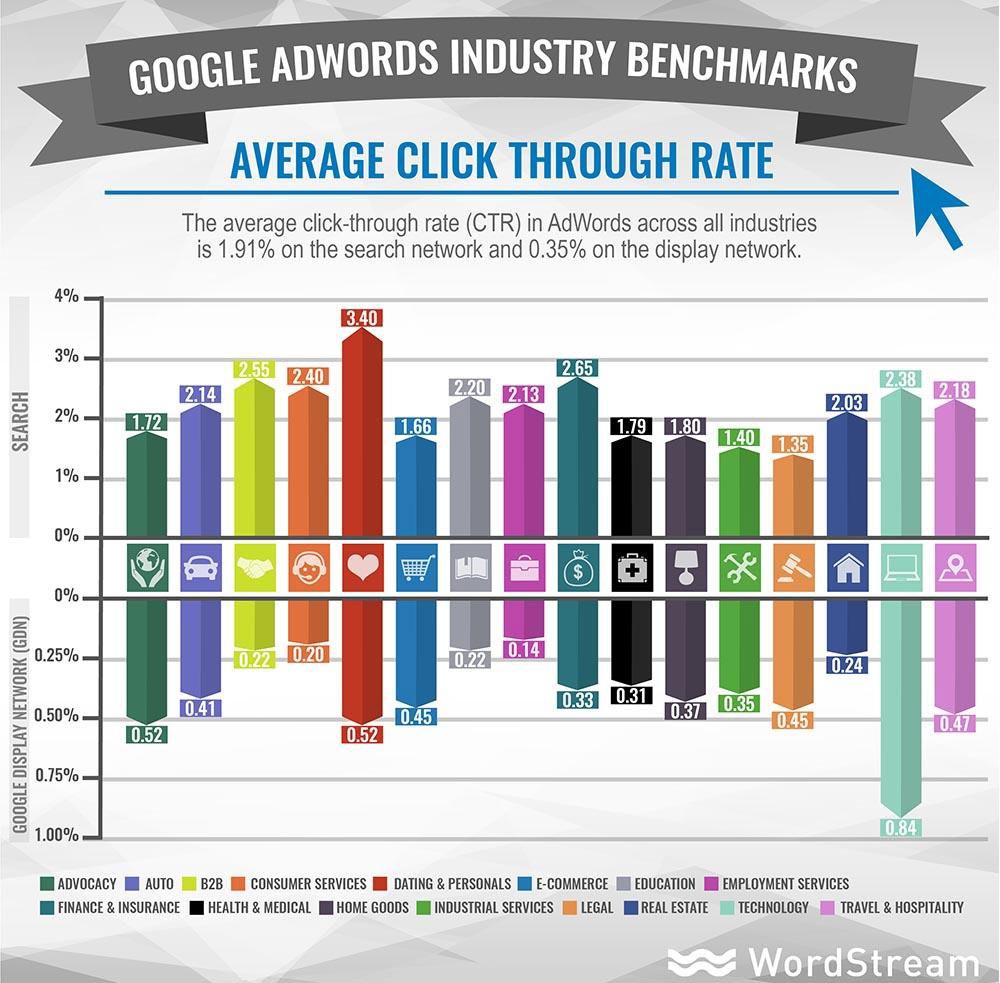
(Image Credit: WordStream)
A closer look at the research reveals that certain industries react differently to the ads. For instance, the travel and hospitality industry offers a relatively high CTR on the search ads compared to other industries, while the same industry offers an average result for display ads.
Similarly, the real estate industry may offer much better results on the display network compared to search ads. The CTR of the real estate industry on the display network is almost three times higher than some of the other major sectors.
While the overall Google AdWords ctr benchmark is higher than the display ads, you should not assume that search ads offer better results. It’s essential to realize that click-through-rate just offers one piece of information – how many visitors will click the ad? It doesn’t provide information on what it will cost you to advertise your ads. We will discuss that in the following section.
When to use click-through-rate CTR?
You should use CTR as your primary benchmark if you know the cost of advertisement and you have prior data on customer conversions. It means that you should already have some idea of how many customers will convert and how much you are going to pay for your ad. We will discuss CPC cost-per-click and CTA cost-per-action next.
Click-through-rate is also used by companies for A/B testing. Such tests allow the advertiser to evaluate the click-through-rate on different types of ads. By testing multiple ads, advertisers can identify the best ad they can use for the advertisement campaign.
Another use of the CTR is to understand the behavior of the customer after they click on the ad. For instance, if you know the cost of the ad and the click-through-rate, you can evaluate the financial feasibility of your ad after testing how many customers will buy your product after the click.
CPC (Cost-Per-Click)
The cost per click tells you how much you can expect to pay for a click if you advertise using Google Adwords.
For small and medium-sized businesses with a limited budget, it’s one of the most useful Google ads industry benchmarks because it allows businesses to easily define their budget.
If you’re in the real-estate sector, a CPC of $2.37 on a search ad lets you know that you can expect to pay $2.37 for a potential customer to click on your ad. While it doesn’t tell you if the customer will buy from you, it offers a simple insight so you can set a budget for your campaign.
Here is an overview of the Google search benchmarks related to CPC:
Google Search Benchmarks
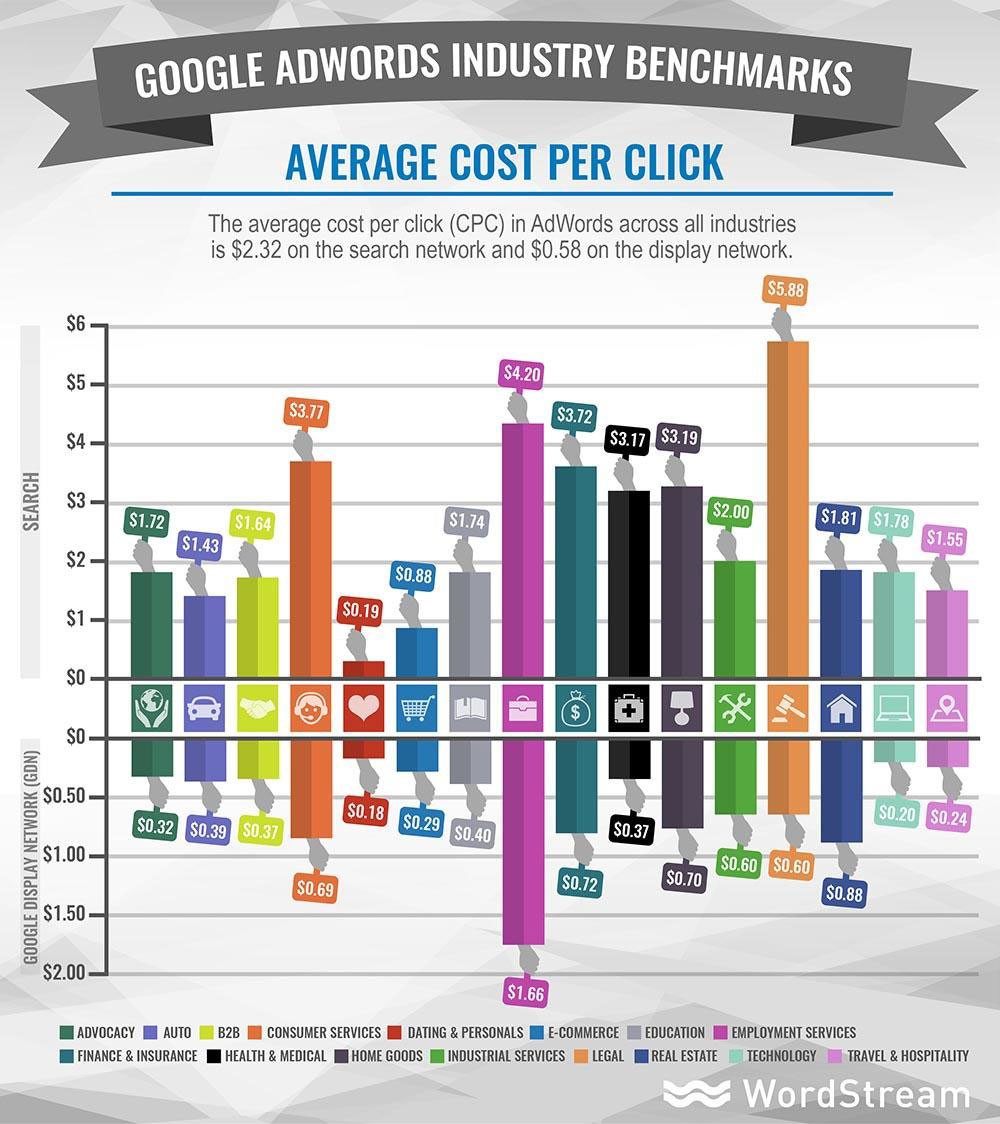
(Image Credit: WordStream)
Looking at the table, it’s not surprising that the cost per click for legal and consumer services is much greater than in traditional sectors. The cost is high because these services also charge a higher fee per customer. Interestingly, the low cost of dating and personal service on display networks also stands out.
Comparing the CPC table to the CTR table in the previous section, we can also see that the cost per click on the Google display network is cheaper than Google search ads. While the opposite is true for the Google display network, where the conversion rate is much lower than Google search ads. It also tells us that it may not be practical to rely on only one of the Google AdWords industry benchmarks.
When to use cost-per-click CPC?
Almost anyone can use CPC ads and related metrics to understand the cost they will incur when running Google ads. It is a relatively simple and effective method to define your budget.
Apart from comparing your Google ad campaign against your competitors, CPC benchmarks also give you a chance to understand the dynamics of Google ads and Google display network. Looking at the numbers, it’s apparent that you will likely pay much more for advertising your ads on the search results compared to ads on the Google display network.
However, if you need laser-targeted traffic, then Google search may be a great choice because your ads will be displayed to a very specific audience. In contrast, you may pay a much lower price on Google display network but you will need to define your audience. It’s also possible that your ads may not reach the intended viewer.
CPA (Cost-Per-Action)
A cost per action refers to the price that advertisers pay for taking an action. Such an action can refer to a sale, click, filling of a form, or newsletter signup.
For almost every advertiser, the cost of action is a very useful metric because it lets them easily understand the cost they may pay to acquire a customer.
If you know that your profit on a certain product is $200 and it will cost you $125 to acquire a customer through Google Ads, advertising on Google may be worth every penny. While deciphering these metrics, you should also understand that this is just the average cost of advertising, which may be much less for you if you know how to tweak your ads to get the maximum benefit.
Here is an overview of the Wordstream research related to CPA:
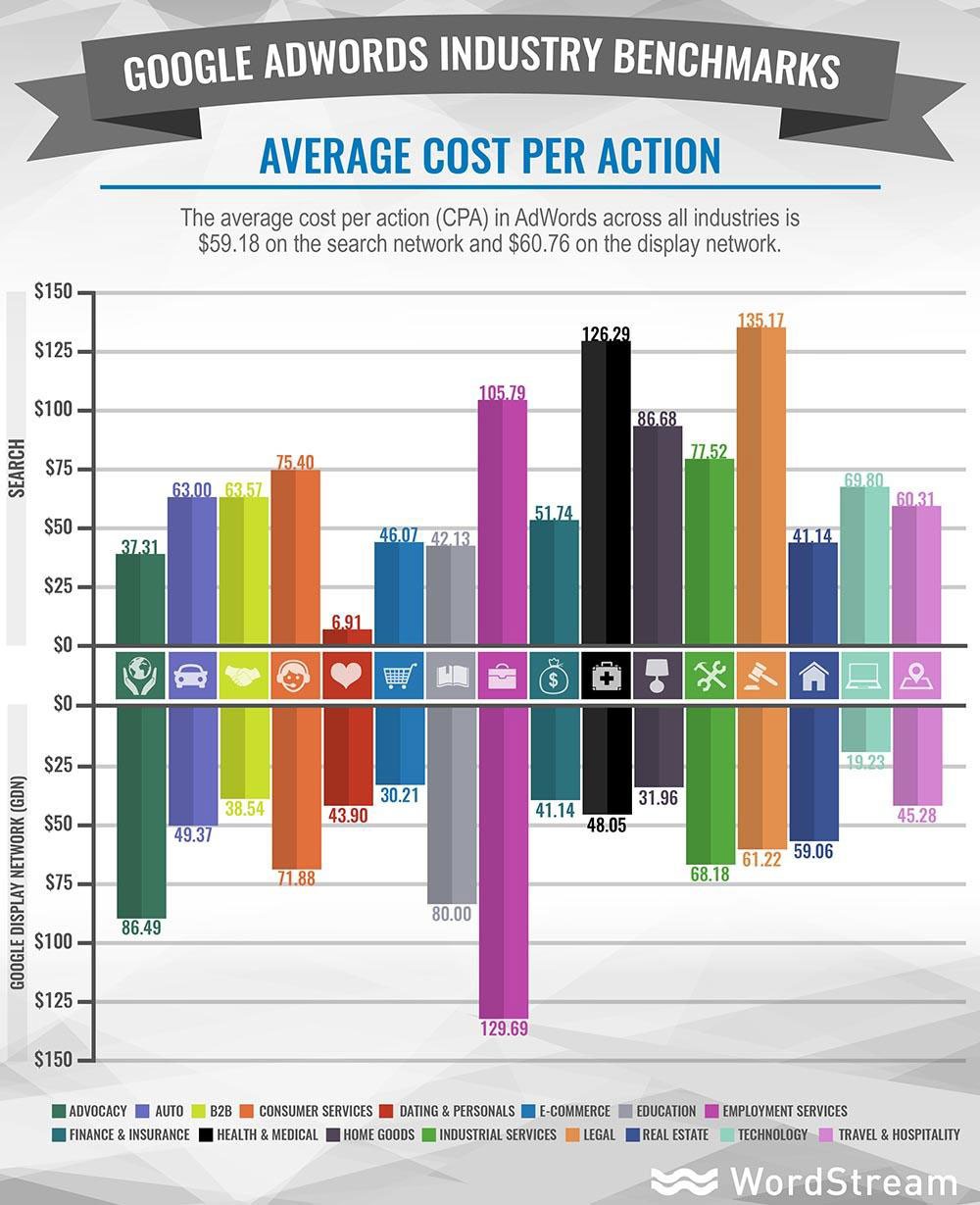
(Image Credit: WordStream)
Since cost per action is often the final step in the sales funnel, the above statistics reveal that there is a wide variance in the ad channel that you should use. If we were to select a search ad or display ad based on these numbers only, the choice of ad platform will vary depending on your industry.
It also shows that CTR and CPC are only relevant if you know how to use them to your advantage. For instance, the legal sector has the highest cost-per-click among the major industries but its cost per action is among the lowest. If you’re a lawyer, you may have to initially pay a high cost for advertisements but the cost to acquire a customer may be lower.
You should also note that the cost per action may mean a lot of different things. From a law firm perspective, it can either mean the cost to fill an online form or the cost to call the law office.
When to use cost-per-action CPA?
The cost per action is an extremely useful benchmark, which should enable anyone to get an overview of the cost to acquire a lead. It’s also a great tool that will allow you to evaluate if Google Ads is the right channel to advertise your products. However, the cost per action can often mislead you if you don’t know what it is measuring.
We hope that you found this article useful.
If you want to know more interesting about your site health, get personal recommendations and alerts, scan your website by Diib. It only takes 60 seconds.
When To Use Google Search Ads Or Google Display Network?
Here are some well-known reasons to use search ads:
- If you want quick results and laser-targeted traffic, it’s reasonable to use search ads.
- Google search ads are perfect for targeting local traffic. Whenever someone living in the vicinity of your business types a relevant keyword related to your business or product, your ad will automatically show up in Google search results.
- Search ads are great for products that have a short sales cycle. If you don’t want to remarket your ads to the audience, search ads are a preferred choice for advertisers.
- Search ads also make sense for emergency services such as plumbing, locksmith, and auto tow trucks. It’s unlikely that someone reading a blog will click on such ads if they don’t require such services.
In contrast, here are four reasons when you should use display ads:
- If your business is better off showing visual ads, then Google display network may be a better choice than google ads.
- Google ads network is a better choice for creating awareness and brand recognition among potential customers. It can re-target users according to your desired parameters.
- A product or service with a longer sales cycle that needs to interact with customers at multiple touchpoints should use display ads.
- If you want to reach a niche market and similar websites where customers are already spending their time, there is no better alternative than a display ad. Using a display ad, you can also target customers who visit a specific website.
Diib®: Benchmarks You Can Understand!
Benchmarks can be an intimidating measurement for any website owner to get a handle on. At Diib, we pride ourselves on giving our clients usable information, in terms they can understand. Additionally, our objectives give you suggestions for improving your benchmark measurements and ad performance. Here are some of the features you’re sure to love:
- Customized Objectives give you simple tasks designed to optimize your website and google ad benchmarks
- Alerts that tell you about your Domain Authority other technical SEO issues
- Bounce rate monitoring and CTR
- Post performance
- Broken pages where you have backlinks (404 checker)
- Keyword, backlink, and indexing monitoring and tracking tools
- User experience and mobile speed optimization
Click here for your free scan or simply call 800-303-3510 to speak to one of our growth experts.
FAQ’s
A good, average CTR for your AdWords paid ads is around 2%. Anything over this should be considered as above average. On the Display Network, CTR’s are going to be lower which is why attractive displays are so important.
A higher CTR means a higher Quality Score, which will reduce your costs and raise your ad rank. Not only is it vital in AdWords, but a high CTR is important in other marketing channels.
While improved SEO helps your Google Search ranking, Google Ads don’t improve your SEO rankings.
Average cost-per-click (avg. CPC) is calculated by dividing the total cost of your clicks by the total number of clicks. Your average CPC is based on your actual cost-per-click (actual CPC), which is the actual amount you’re charged for a click on your ad.
More clicks often lead to more conversion, at the very least it means more CHANCES for conversions. If you average cost per acquisition isn’t hitting your margins, bidding higher just means more conversions for a small additional cost.
